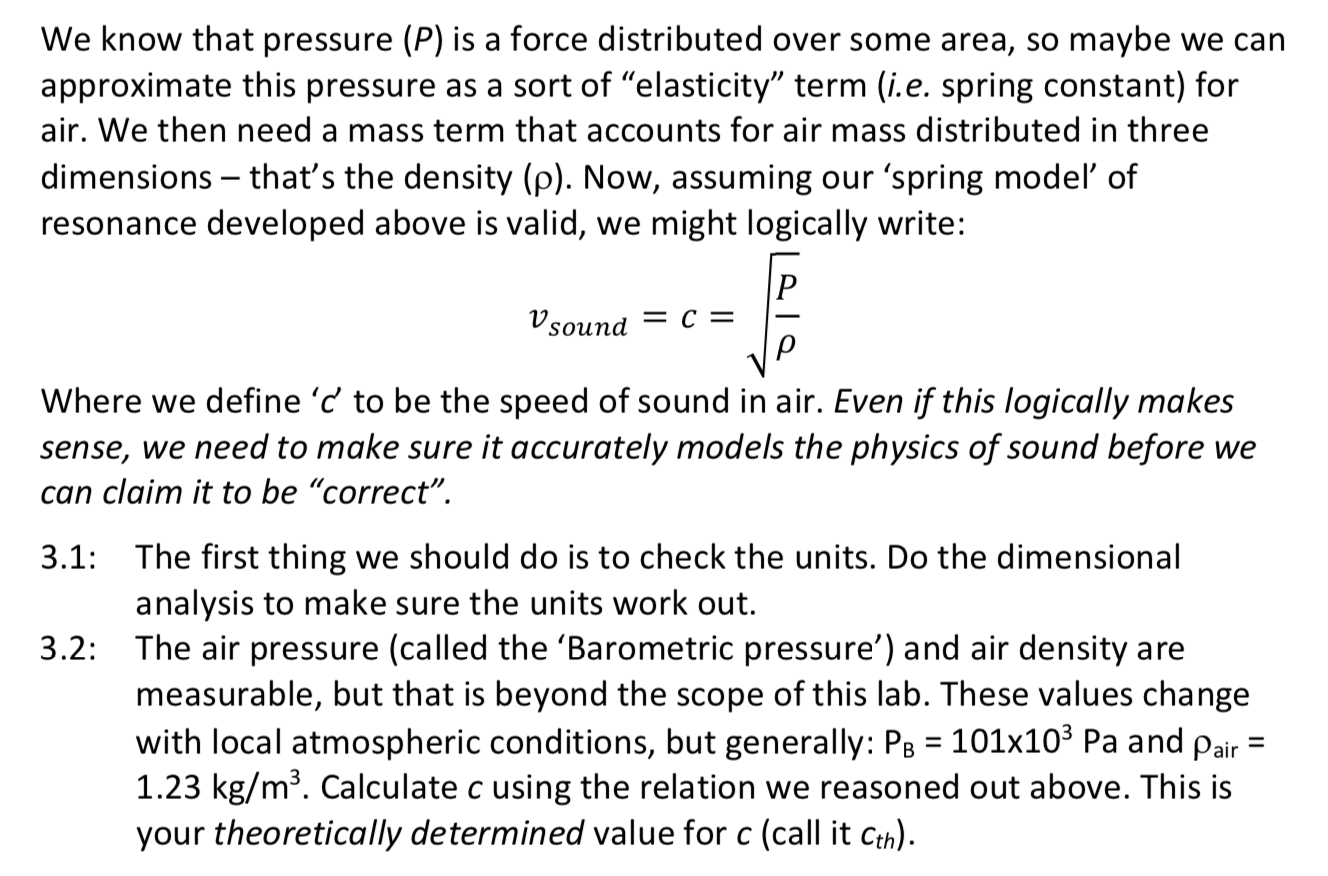We know that pressure (P) is a force distributed over some area, so maybe we can approximate this pressure as a sort of "elasticity" term (i.e. spring constant) for air. We then need a mass term that accounts for air mass distributed in three dimensions – that's the density (p). Now, assuming our 'spring modeľ of resonance developed above is valid, we might logically write: Vsound = c = Where we define 'c' to be the speed of sound in air. Even if this logically makes sense, we need to make sure it accurately models the physics of sound before we can claim it to be "correct". 3.1: The first thing we should do is to check the units. Do the dimensional analysis to make sure the units work out. 3.2: The air pressure (called the 'Barometric pressure') and air density are measurable, but that is beyond the scope of this lab. These values change with local atmospheric conditions, but generally: PB = 101x10³ Pa and pair = 1.23 kg/m³. Calculate c using the relation we reasoned out above. This is your theoretically determined value for c (call it Cth).
We know that pressure (P) is a force distributed over some area, so maybe we can approximate this pressure as a sort of "elasticity" term (i.e. spring constant) for air. We then need a mass term that accounts for air mass distributed in three dimensions – that's the density (p). Now, assuming our 'spring modeľ of resonance developed above is valid, we might logically write: Vsound = c = Where we define 'c' to be the speed of sound in air. Even if this logically makes sense, we need to make sure it accurately models the physics of sound before we can claim it to be "correct". 3.1: The first thing we should do is to check the units. Do the dimensional analysis to make sure the units work out. 3.2: The air pressure (called the 'Barometric pressure') and air density are measurable, but that is beyond the scope of this lab. These values change with local atmospheric conditions, but generally: PB = 101x10³ Pa and pair = 1.23 kg/m³. Calculate c using the relation we reasoned out above. This is your theoretically determined value for c (call it Cth).
University Physics Volume 1
18th Edition
ISBN:9781938168277
Author:William Moebs, Samuel J. Ling, Jeff Sanny
Publisher:William Moebs, Samuel J. Ling, Jeff Sanny
Chapter15: Oscillations
Section: Chapter Questions
Problem 70CP: Parcels of air (small volumes of air) in a stable atmosphere (where the temperature increases with...
Related questions
Question
How do I go about the two-part question for this topic of acoustic resonance?

Transcribed Image Text:We know that pressure (P) is a force distributed over some area, so maybe we can
approximate this pressure as a sort of "elasticity" term (i.e. spring constant) for
air. We then need a mass term that accounts for air mass distributed in three
dimensions – that's the density (p). Now, assuming our 'spring modeľ of
resonance developed above is valid, we might logically write:
Vsound = c =
Where we define 'c' to be the speed of sound in air. Even if this logically makes
sense, we need to make sure it accurately models the physics of sound before we
can claim it to be "correct".
3.1: The first thing we should do is to check the units. Do the dimensional
analysis to make sure the units work out.
3.2: The air pressure (called the 'Barometric pressure') and air density are
measurable, but that is beyond the scope of this lab. These values change
with local atmospheric conditions, but generally: PB = 101x10³ Pa and pair =
1.23 kg/m³. Calculate c using the relation we reasoned out above. This is
your theoretically determined value for c (call it Cth).
Expert Solution
This question has been solved!
Explore an expertly crafted, step-by-step solution for a thorough understanding of key concepts.
This is a popular solution!
Trending now
This is a popular solution!
Step by step
Solved in 2 steps with 1 images

Knowledge Booster
Learn more about
Need a deep-dive on the concept behind this application? Look no further. Learn more about this topic, physics and related others by exploring similar questions and additional content below.Recommended textbooks for you

University Physics Volume 1
Physics
ISBN:
9781938168277
Author:
William Moebs, Samuel J. Ling, Jeff Sanny
Publisher:
OpenStax - Rice University

Classical Dynamics of Particles and Systems
Physics
ISBN:
9780534408961
Author:
Stephen T. Thornton, Jerry B. Marion
Publisher:
Cengage Learning

University Physics Volume 1
Physics
ISBN:
9781938168277
Author:
William Moebs, Samuel J. Ling, Jeff Sanny
Publisher:
OpenStax - Rice University

Classical Dynamics of Particles and Systems
Physics
ISBN:
9780534408961
Author:
Stephen T. Thornton, Jerry B. Marion
Publisher:
Cengage Learning